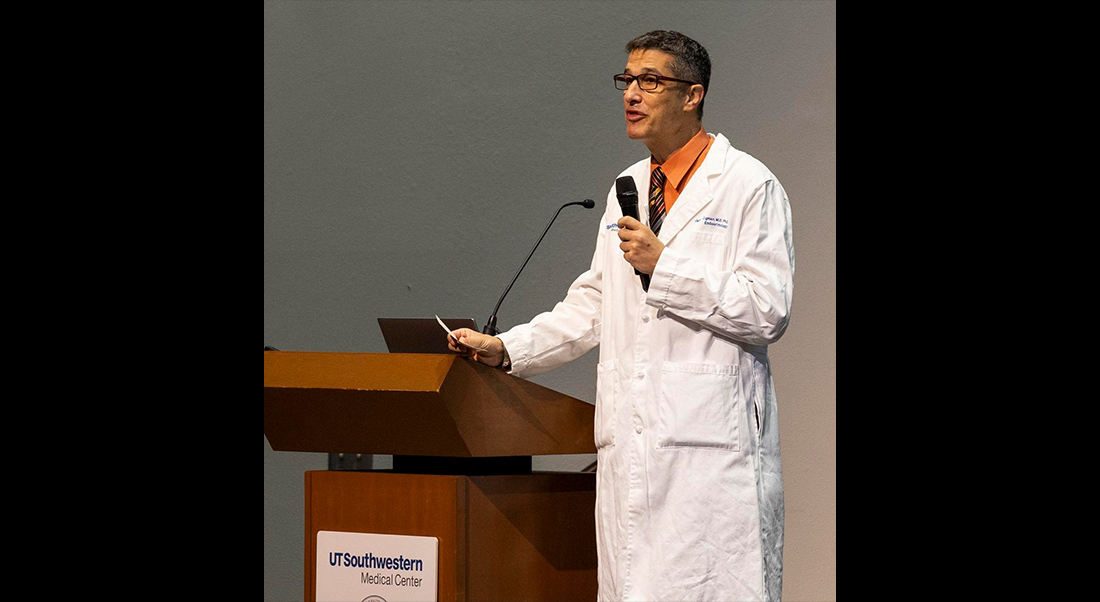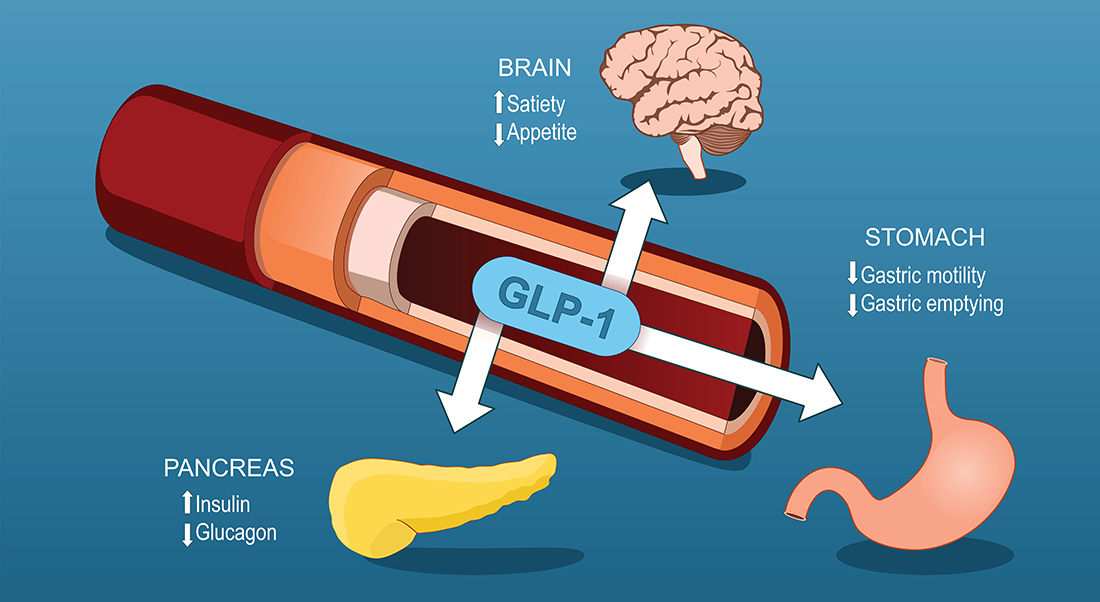

As weight-loss drugs capture the public’s imagination, UTSW and its Nutrition Obesity Research Center are uniquely positioned to lead the way in discovery, education, and community outreach
The “Ozempic Revolution” did not start with celebrities posting their weight-loss success stories on Instagram, or slick TV ads featuring the earworm jingle: “Oh, Oh, Oh, Ozempic!”
The origin story of today’s blockbuster diabetes and weight-loss drugs known as glucagon-like peptide-1 receptor agonists, or GLP-1RAs for short, can be traced to two decidedly less glamorous creatures: the anglerfish and the Gila monster. Decades of research that spanned from Boston to Brussels led to important discoveries related to the hormone glucagon and associated peptides – first in the guts of the fish, then in the venom of the lizard, and eventually in humans.
But 20 years before the Gila monster and anglerfish breakthroughs, there was the essential work of UT Southwestern endocrinologist Roger H. Unger, M.D., who in the late 1960s identified the role of glucagon in the pathogenesis of diabetes. His findings and those of many others at UT Southwestern – including 1985 Nobel Prize recipients Michael Brown, M.D., and Joseph Goldstein, M.D., – have contributed to generations of elegant research related to metabolic health, nutrition, and associated conditions that has helped bring the research community to the precipice of a major shift in the way we view and treat obesity, a chronic health condition that affects 42% of the U.S. population.
Collectively, the advances in glucagon research helped create a blueprint for the game-changing medications best known today as semaglutide (Ozempic, Wegovy) and tirzepatide (Mounjaro, Zepbound), which help control blood sugar, slow digestion, suppress appetite, and produce profound weight loss. In a poll taken this year, an estimated 12% of American adults said they were taking a GLP-1RA to help them lose weight or to treat diabetes or heart disease. And that number is rising rapidly.
Like any revolution, particularly in science, it takes a sustained collaborative effort to bring about lasting change. That’s why the National Institutes of Health has funded Nutrition Obesity Research Centers (NORC) around the country at academic medical centers known for their achievements in obesity and metabolism research. Among the 11 hubs are Harvard Medical School; University of California, San Francisco; the University of Michigan; and UT Southwestern – the only center in Texas, approved in 2022.

Jay Horton, M.D., Professor of Internal Medicine and Molecular Genetics, is Director of the?Center for Human Nutrition and the Nutrition Obesity Research Center.
The timing couldn’t be better.
“The entire world is talking about weight-loss drugs and metabolic hormones, and we are one of the leaders in this field,” said Jay Horton, M.D., Professor of Internal Medicine and Molecular Genetics and Director of the Center for Human Nutrition and NORC, which established four core facilities for advanced lab services in Animal Phenotyping/Metabolism; Lipid Mass Spectrometry; Quantitative Metabolism and Imaging; and Genetics, Single Cell Sequencing, and RNA Sequencing. Over the last two years, more than 180 scientists across 27 departments at UTSW have come together to accelerate the translation of basic scientific research into potential treatments. Working mostly behind the scenes, they investigate some of the most pressing questions regarding metabolism and obesity-related conditions.
“We have assembled a highly interactive and collaborative team of investigators,” said Dr. Horton, “with a goal of defining the behavioral, metabolic, genetic, and molecular mechanisms contributing to obesity and obesity-induced disease.”
UTSW’s NORC is making an impact beyond the lab, connecting with people in the community who have real questions about this so-called revolution and whether there is a place in it for them.

Jeffrey Zigman, M.D., Ph.D., is Professor of Internal Medicine and a Principal Investigator in the Center for Hypothalamic Research.
“This is such a huge problem in our society, and it infiltrates nearly all aspects of our lives,” said Jeffrey Zigman, M.D., Ph.D., Professor of Internal Medicine and a Principal Investigator in the Center for Hypothalamic Research who directs NORC’s Enrichment Program. “We need to support existing and new researchers who are investigating the molecular basis for the development of obesity. We need to foster collaborative efforts with other researchers around the country and the world. And we must reach out to members of our community.
“NORC is a vehicle to cover all those aspects of obesity research, obesity care, and obesity education,” he added.
At the forefront of discovery
Roger Unger, M.D., discussed his research into diabetes in 2018 during UT Southwestern’s 75th anniversary.
Prior to his death at age 96 in August 2020, Dr. Unger sat down for an interview to reflect on his 64 years at UT Southwestern. He spoke about his drive for discovery in identifying the essential role of glucagon in the pathogenesis of diabetes.
“Every time I decided to retire,” he said with a wry smile, “we’d stumble onto something too good to let go. So, we’d keep going.”
That perseverance and dedication to metabolic health research has become a hallmark of UT Southwestern. The tradition continued with Dr. Brown, Professor of Molecular Genetics, and Dr. Goldstein, Chair and Professor of Molecular Genetics, who discovered the low-density lipoprotein (LDL) receptor and its role in cholesterol regulation, which was honored with the Nobel Prize and led to the development of statin drugs as a standard treatment for cardiovascular disease. Today, millions of people take a statin to control their cholesterol. More recently, Helen Hobbs, M.D., Howard Hughes Medical Institute Investigator and Professor of Internal Medicine and Molecular Genetics, won the 2016 Breakthrough Prize in Life Sciences and the 2018 Harrington Prize for Innovation in Medicine for her discoveries in lipid metabolism and fatty liver disease.
UTSW’s Center for Human Nutrition, led for 32 years by founding Director Scott Grundy, M.D., Ph.D., was the first such enterprise at an American medical school. The list of scientists and clinicians at UTSW who have made major contributions to the field of obesity and metabolic health is long and includes multiple Howard Hughes Medical Institute Investigators and members of the National Academy of Sciences and National Academy of Medicine.
The NORC represents a logical next step for UTSW. The University lends institutional support to investigators who collectively receive $74 million in annual grant funding for nutrition- and obesity-related research, some of which has already led to significant contributions to preclinical studies on incretin hormones and their positive effects on the heart and brain.
Ildiko Lingvay, M.D., Professor of Internal Medicine in the Division of Endocrinology, was first author on a nationally recognized study that showed semaglutide lowered the risk of major adverse cardiovascular events by an average of 20% regardless of a patient’s blood sugar. Kevin Williams, Ph.D., Associate Professor of Internal Medicine in the Center for Hypothalamic Research, recently published a study in Science that identified two populations of neurons in the dorsomedial hypothalamus that semaglutide and tirzepatide activate: one that turns on at food exposure and another that turns on when eating begins. His team’s ongoing research could help improve the efficacy of the drugs in treating metabolic conditions.
UT Southwestern has also received state funding – about $6 million to $8 million per year from 2009-2019 – to support obesity-related research and to help recruit top scientists.

Philipp Scherer, Ph.D., Professor of Internal Medicine and Cell Biology, is Director of the?Touchstone Center for Diabetes Research and Associate Director of the Nutrition Obesity Research Center.
“As we see these trends arise in the field, this intellectual space we’re creating will allow us to stay at the forefront of scientific discovery,” said Philipp Scherer, Ph.D., Professor of Internal Medicine and Cell Biology, Director of the Touchstone Center for Diabetes Research, and Associate Director of NORC at UTSW. “It provides an infrastructure that stretches across departments and specialties.”
Planting the seeds of change
One of the central aspects of NORC is the pilot and feasibility grant program, directed by Joel Elmquist, D.V.M., Ph.D., Professor of Internal Medicine and Director of the Center for Hypothalamic Research, and Joyce Repa, Ph.D., Associate Professor of Physiology and Internal Medicine. The grants fund early-stage projects related to nutrition and obesity research every year; eight scientists have been awarded $50,000 each.
Kelseanna Hollis-Hansen, Ph.D., Assistant Professor in the Peter O’Donnell Jr. School of Public Health, was a recipient. Her clinical study is just one example of research that has real-world applications for patients and could set the stage for major research projects in the future.

Kelseanna Hollis-Hansen, Ph.D., is Assistant Professor in the Peter O'Donnell Jr. School of Public Health at UT Southwestern.
She and Dr. Lingvay, her co-investigator, have set out to evaluate effective strategies to stave off weight fluctuations after discontinuing GLP-1 medications, which, though effective, can be cost prohibitive. Ozempic and Wegovy can range from $900 to $1,300 a month without insurance coverage.
“When people stop taking these medications, we typically see a significant increase in weight a few months later,” Dr. Hollis-Hansen said. “So, we are recruiting participants for a four-month study with the goal of reducing that marked increase and providing better supportive care.” The study will measure whether behavioral interventions or food access is more crucial to improving weight maintenance, which can influence future policy decisions.
“This is a credit to the Nutrition Obesity Research Center,” she said. “It provides us grant funding, as well as the expertise of other researchers and faculty, and the access to state-of-the-art lab services and core facilities.” Dr. Hollis-Hansen will be one of the speakers at the upcoming Weight Wellness Day.

Amanda Casey, Ph.D., is Assistant Professor of Molecular Biology at UT Southwestern.
Other NORC-funded projects focus on metabolic diseases and pathways. Last year, Amanda Casey, Ph.D., Assistant Professor of Molecular Biology, studied FIC domain protein adenylyltransferase (FICD), an enzyme that regulates cell function, and the impact of high-fat diets and intermittent fasting and feeding on enzyme activity. Her work led to a grant renewal and a follow-up study to further examine a specific genetic mutation and its link to neonatal diabetes, a rare and complex congenital disorder.
“If we can find a way to control this additional factor, it could potentially improve people’s digestion or even their diabetes,” said Dr. Casey. “That is the value of having these resources at UT Southwestern. It sets you up for success by providing you the tools you need to answer any scientific question.”
Reaching out and pushing forward
One of the stated goals of UTSW’s NORC is to develop the next generation of nutrition and obesity researchers.
To that end, UTSW has created a summer internship program, led by Rodney Infante, M.D., Ph.D., Associate Professor in the Center for Human Nutrition, for promising high school students who are underrepresented in science to work in research labs. The NORC also supports a weekly seminar series focused on obesity and related research and organizes the McGarry Symposium, named for John Dennis McGarry, Ph.D., who dedicated his 34-year career at UTSW to diabetes research and made a series of groundbreaking contributions to the understanding of fat metabolism.
The university has also built a new graduate track for doctoral students to pursue a specialty in molecular metabolism and metabolic diseases – one of only a few such programs in the United States. “UT Southwestern is one of the leading centers in the world in this arena,” Dr. Zigman said. “This graduate track and all the work we are putting into the Research Center solidify that.”
Another NORC directive is to effectively communicate advances in the study of nutrition, obesity, and metabolic syndrome to the public, which is where the annual Weight Wellness Day event comes in.
On Saturday, Sept. 14, at the T. Boone Pickens Biomedical Building, UT Southwestern will again share evidence-based strategies for health improvements related to obesity, with UTSW experts discussing topics such as common myths about weight and weight loss, the risks and benefits of Ozempic and similar GLP-1 drugs, and what to expect before and after bariatric surgery. Attendees will also have time to interact with experts during Q&A sessions and observe a healthy cooking demonstration.
“The percentage of our population who struggle with obesity and weight wellness has grown significantly, so there is a greater need for accurate information,” Dr. Zigman said. “Lots of people have heard about Ozempic. They’ve also heard all the myths about it. So, this event will be a good opportunity for people to get honest answers to their questions.”
Dr. Lingvay has received personal consulting compensation from Novo Nordisk and Eli Lilly, the pharmaceutical companies that manufacture the weight-loss drugs. Dr. Williams and Dr. Zigman are shareholders of Novo Nordisk and Eli Lilly.
Dr. Brown holds the Paul J. Thomas Chair in Medicine and The W.A. (Monty) Moncrief Distinguished Chair in Cholesterol and Arteriosclerosis Research. He is a Regental Professor.
Dr. Elmquist holds the Carl H. Westcott Distinguished Chair in Medical Research and the Maclin Family Distinguished Professorship in Medical Science, in Honor of Dr. Roy A. Brinkley.
Dr. Goldstein holds the Julie and Louis A. Beecherl, Jr. Distinguished Chair in Biomedical Research and the Paul J. Thomas Chair in Medicine. He is a Regental Professor.
Dr. Hobbs holds the 1995 Dallas Heart Ball Chair in Cardiology Research.
Dr. Horton holds the Center for Human Nutrition Director’s Endowed Chair, the Scott Grundy Director’s Chair, and the Distinguished University Chair in Human Nutrition.
Dr. Infante holds the Kern and Marnie Wildenthal President’s Research Council Professorship in Medical Science.
Dr. Scherer holds the Gifford O. Touchstone, Jr. and Randolph G. Touchstone Distinguished Chair in Diabetes Research and the Touchstone/West Distinguished Chair in Diabetes Research.
Dr. Zigman holds the Kent and Jodi Foster Distinguished Chair in Endocrinology, in Honor of Daniel Foster, M.D.; The Diana and Richard C. Strauss Professorship in Biomedical Research; and the Mr. and Mrs. Bruce G. Brookshire Professorship in Medicine.





